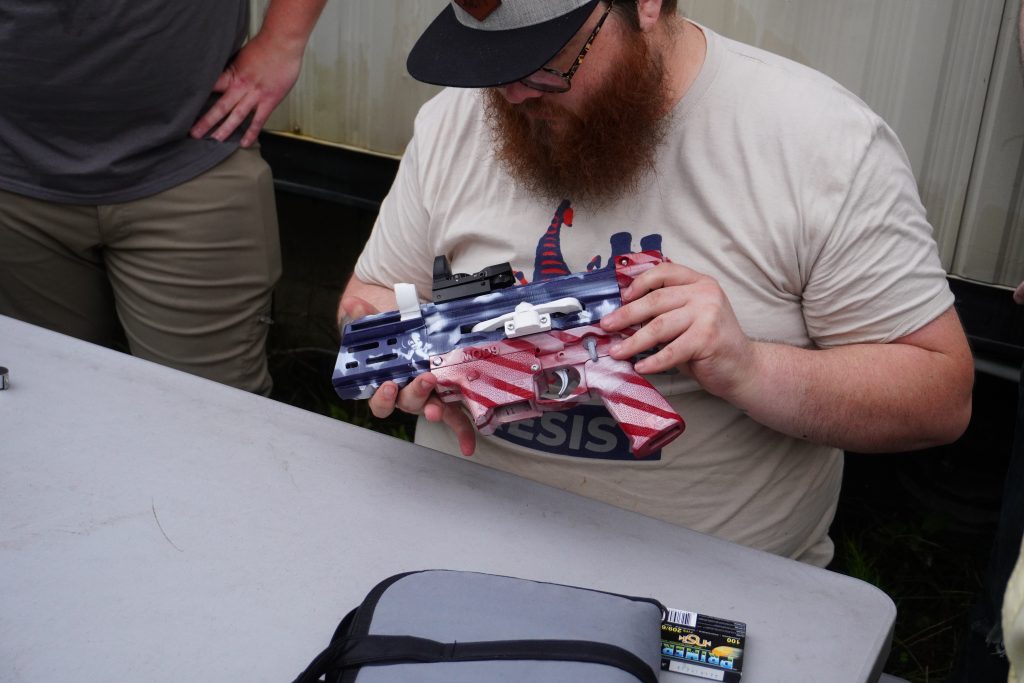This week, we saw an increasingly familiar sight. The Supreme Court declined to hear a Second Amendment challenge. The explanation for why is familiar, too.
Justice Clarance Thomas implied the Court didn’t think the case was developed enough to take up. Contributing Writer Jake Fogleman looks at how closely that explanation matches the other ones conservative justices have given when the Court has denied previous Second Amendment cases. It may be worth asking if this trend is reason to think the Court has lost interest in expanding on its gun-rights jurisprudence.
The revelation that the man who killed UnitedHealthcare’s CEO used a 3D-printed gun was the other top story of the week. I spoke with several pioneers and activists in the homemade gun community to get their take on what the news means for them. Plus, Gun Maker’s Match founder Rob Pincus joins the podcast to give a more in-depth take on where this might push things.
Oh, also, some of you fine people have nominated me for a Gundie as the Top 2A Writer. I’m very flattered to be nominated and greatly appreciate the support for what we’re trying to do here at The Reload. If you’d like to vote for me to win the award at this year’s SHOT Show in Las Vegas, you can head over to The Gundies’ website.

Analysis: SCOTUS ‘Spirit of Aloha’ Denial Part of Worrying Trend for Gun Activists [Member Exclusive]
By Jake Fogleman
The Supreme Court rejected yet another high-profile Second Amendment case, raising questions about its appetite for expanding gun rights.
On Monday, the justices denied cert in Wilson v. Hawaii, a case on appeal from the Hawaii Supreme Court concerning criminal gun charges against a man who carried a firearm without a permit in 2017. The charges came during an era when the state refused to grant gun permits to its citizens under a licensing regime later found unconstitutional by the Supreme Court in Bruen. The Hawaii court both intentionally and flagrantly rebuked the High Court in deciding to reinstate those charges based in part on the “Spirit of Aloha.”
Despite that, the Court allowed the decision to stand. The reasoning behind the denial is increasingly familiar.
“Although the interlocutory posture of the petition weighs against correcting this error now,” Justice Clarence Thomas wrote in a statement on the denial, joined by Justice Samuel Alito, “I would grant certiorari in an appropriate case to reaffirm that the Second Amendment warrants the same respect as any other constitutional right.”
The statement stands out for its similarity to others issued by the same few conservative justices on rejected gun cases over the last year. The Court as a whole does not reveal its thinking when it chooses not to take up a case. But statements like Thomas’s provide breadcrumbs that may lead back to what the rest of the Court is thinking about a given issue. Since Bruen was decided in 2022, Justices Thomas and Alito have been dropping a lot of them.
The first instance came shortly after Bruen, when policymakers in New York pushed back against that decision by passing a replacement concealed carry law that was, at least in some ways, stricter than what the Court had just struck down. A federal judge blocked broad swathes of the law, but the Second Circuit stayed that injunction and reinstated the law. When gun-rights advocates sought relief from the Supreme Court over a Second Amendment subject it had just willingly addressed a few months prior, the Justices declined to get involved. Justice Alito, joined by Justice Thomas, wrote separately in a statement respecting the denial.
“I understand the Court’s denial today to reflect respect for the Second Circuit’s procedures in managing its own docket, rather than expressing any view on the merits of the case,” Alito wrote. “Applicants should not be deterred by today’s order from again seeking relief if the Second Circuit does not, within a reasonable time, provide an explanation for its stay order or expedite consideration of the appeal.”
The next example came this July. The Seventh Circuit overturned a lower court’s preliminary injunction against the Illinois “assault weapons” ban in an opinion that ruled AR-15s and other targeted guns aren’t even “arms” under the Second Amendment. Gun rights advocates appealed to the Supreme Court, but the Justices again declined. Thomas wrote another statement citing the early stage of the case as the main reason the Court didn’t want to get involved.
“This Court is rightly wary of taking cases in an interlocutory posture,” he wrote. “But, I hope we will consider the important issues presented by these petitions after the cases reach final judgment. We have never squarely addressed what types of weapons are ‘Arms’ protected by the Second Amendment.”
All three examples fit a trend of a minority of conservative justices agreeing with the Court’s decision not to hear a given case due to its procedural posture while nevertheless agreeing with the petitioners on the constitutional infirmity of the law in question, in a sort of consolation opinion. The most recent examples have been particularly forthright in that regard.
Thomas referred to the Seventh Circuit’s Illinois AR opinion as “nonsensical” and “unmoored from both text and history.”
“If the Seventh Circuit ultimately allows Illinois to ban America’s most common civilian rifle, we can—and should—review that decision once the cases reach a final judgment,” he wrote. “The Court must not permit ‘the Seventh Circuit [to] relegat[e] the Second Amendment to a second-class right.’”
In the statement this week, he similarly accused the Hawaii Supreme Court of “ignor[ing] our holding” in Bruen.
“The decision below is the latest example of a lower court ‘fail[ing] to afford the Second Amendment the respect due an enumerated constitutional right,’” he wrote. “This Court’s intervention clearly remains imperative, given lower courts’ continued insistence on treating the Second Amendment ‘right so cavalierly.’”
While gun-rights advocates might appreciate Thomas’ sentiments, they’re no doubt disappointed not to see them in an actual majority opinion. It’s one thing to repeatedly write about the need to safeguard the Second Amendment against inadequate treatment from lower courts. It’s quite another to actually do it.
Aside from this week’s Wilson denial, where Justice Gorsuch joined with a similar statement, none of the other conservative justices have signed onto or issued any statements echoing Thomas and Alito’s sentiments. This could suggest that the Court’s view on this is not evenly distributed among the justices—or even just the conservative ones. After all, it only takes four votes to grant a cert petition, and only one to three conservatives have said anything about these post-Bruen Second Amendment challenges.
The lack of final judgment has been the common rationale cited for not taking another gun-rights case. Perhaps that’s truly what’s holding things up. Maybe the Court will take up a Second Amendment challenge once it gets a Goldilocks case.
However, it’s worth noting that the Court has, in the past, granted interlocutory appeals in other contexts. That means it isn’t necessarily a hard and fast rule. So, the conservative statements attached to these cert denials may be more cope about why the Court isn’t taking up these gun cases than confidence it soon will.
But if it is simply a matter of procedural posture, then the Justices will have an opportunity to quiet gun-rights advocates’ concerns when they consider whether to take up the challenge to Maryland’s “assault weapon” ban. That case, which is up on final judgment out of the Fourth Circuit, has been fully briefed and distributed for conference. It also concerns a subject matter that both Justices Thomas and Alito purportedly believe the Court urgently needs to review based on the outcome of the Illinois petition.
If it ultimately opts not to grant the case, gun-rights advocates will have to confront the prospect of a Court that doesn’t appear willing to further expound on the Second Amendment.
Podcast: The Fallout of the CEO Killer’s 3D-Printed Gun (Ft. Maker’s Match Founder Rob Pincus) [Member Early Access]
By Stephen Gutowski
This week, we’re discussing one of the highest-profile assassinations we’ve seen in a long time. One where the killer used a 3D-printed firearm, and video of the attack has been viewed countless times across the country.
To figure out what effect all of that might have on the homebuilt gun community, we’ve got Rob Pincus back on the show. He’s a part-owner of a licensed firearms company but also the organizer of the Gun Maker’s Match.
He explained what it was like to have a foot in both worlds and explained the evolution of home gun making from the 1990s through today. He said the tech had advanced a great deal over time, but most home builds still require factory-made parts, and he hopes to get the industry more involved in that side of the gun business. However, he admitted this month’s high-profile killing is likely to set those efforts back.
Pincus argued the attention is probably going to bring even more scrutiny to 3D-printing guns. That’s likely to amplify the fight over homebuilt firearms. Still, Pincus said he doubts it’ll lead to new restrictions at the federal, or even the state, level.
You can listen to the show on your favorite podcasting app or by clicking here. Video of the episode is available on our YouTube channel. An auto-generated transcript is available here. Reload Members get access on Sunday, as always. Everyone else can listen on Monday.
Plus, Contributing Writer Jake Fogleman and I talk about the NRA’s New York corruption case finally coming to an end after six years. We also discuss the Supreme Court’s latest rejection of a Second Amendment case, the high-profile “Spirit of Aloha” Hawaii gun carry decision. We wrap up by covering the latest reports suggesting the United Healthcare CEO shooter used a 3-D printed gun and what that might mean for homemade gun enthusiasts.

Enthusiasts Worry CEO Killer’s 3D-Printed Gun Could Bring New Restriction Push [Member Exclusive]
By Stephen Gutowski
A 26-year-old Ivy League grad, who suffered a severe back injury, stands accused of murdering UnitedHealthcare’s CEO with a 3D-printed gun.
Video of the killing has been seen by countless millions across the country. Homemade gun pioneers and activists shared details of what the video reveals about the shooter’s gun and, perhaps, his thought process with The Reload. But what do they expect the high-profile killing will mean for the future of 3D-printed guns?
“This incident will be anecdotally referenced forever,” Rob Pincus, who founded a shooting competition for homemade guns, told The Reload.
The Supreme Court of the United States (SCOTUS) is already considering the legality of President Joe Biden’s attempt to crack down on homemade guns in Garland v. VanDerStock. Gun-control advocates have pointed to the slaying as an example of why the Court ought to side with Biden and leave the ATF’s rule treating some unfinished gun parts the same as functioning firearms intact.
“Ghost guns are a criminal’s dream come true,” Emma Brown, executive director of Giffords, said in a statement. “The targeted assassination of UnitedHealthcare CEO Brian Thompson, potentially committed with a ghost gun, shows just how dangerous these weapons are in the wrong hands. Anyone can print them at home or buy unfinished parts online without a background check or training. Yet due to extremists in the gun lobby, the ATF’s rule to stop criminals from getting ghost guns is under threat. Americans’ safety from ghost guns now lies in the hands of the Supreme Court justices. Here’s the bottom line: Ghost guns threaten public safety and must be subject to background checks like the guns they are.”
Pincus is skeptical that the shooting bolsters her argument.
“I think the specific circumstances of this incident are clearly outside of the normal anti-gun narrative that Ghost Guns are primarily criminal tools for people who can’t buy guns in the traditional manner,” Pincus said.
He cited research by members of the Centers for Disease Control (CDC) that was presented at the Research Society for the Prevention of Firearm-Related Harms’s conference this week. It found homemade guns were involved in 97 deaths over 22 years in the agency’s National Violent Death Reporting System.
“It is ironic that this news is breaking at the same time that the first academic study of how frequently Privately Manufactured Firearms have been tied to loss of life,” he said. “From 2001-2023, there were less than 100 cases… and over half of them were suicides. We’ve always believed that the demonization of private gun making (“ghost guns”, etc…) far outweighed any real increase in negative outcomes involving guns. Just as we get some real hard research backing that assertion, we get this very high profile event.”
John, a prominent 3D-printed gun enthusiast and designer who goes by Mr.Snow.Makes online, agreed with that assessment.
“This is certainly the highest-profile instance of a 3D-printed firearm used in a crime,” he told The Reload. “I fully anticipate conversations at the national level, but overall, “ghost guns” account for a very small portion of crime.”
Like Pincus, he argued homemade guns are not a driver of crime and fall far behind traditional factory-made firearms in ATF recovery numbers and CDC data on violent deaths.
“I believe the overall 3D printing firearm community won’t be impacted by this event in the short term,” Snow said. “Federally, making your own firearm for personal use is legal. The ATF defines them as personally manufactured firearms.”
He also noted the shooter had to break numerous laws just to possess his weapon in New York before even carrying out his attack.
“Keep in mind 3D-printed firearms and suppressors are already illegal in New York,” Snow said. “Criminals don’t follow the laws, and the current laws wouldn’t prevent this from happening. Knowing criminals don’t follow the law, the current laws end up restricting access to law-abiding citizens. Criminals generally don’t follow the law, but often times victims of crime do. Additional firearm restrictions would likely only serve to hurt law-abiding citizens by reducing their abilities to defend themselves.”
Matt Larosiere, a gun-rights lawyer involved in the homemade gun community, was less confident about what Thompson’s killing might mean for the gith over homemade guns.
“I’m not sure what the shooting means for the printed gun community,” he told The Reload. “I feel people who wanted to regulate these things anyway will continue to wish for that and that those of us who don’t want them banned will continue to not want them banned.”
However, he agreed with Pincus that the shooter’s lack of a disqualifying criminal record made arguments for further restrictions on 3D printing or other home-building methods unserious. He said it showed gun-control activists are acting in bad faith.
“My biggest takeaway is that gun-control advocates are getting more transparent in their responses to events like these,” Larosiere said. “Where, as here, a restriction on the type of firearm would have done little at all to prevent the event, the focus is still on restricting the particular gun. It seems the restrictive response is based more on targets of opportunity than sound public policy, and I find that concerning.”
Cody Wilson, who became the face of 3D-printed guns after debuting The Liberator in 2013, took a dimmer view of the situation. He has been involved in a legal fight with Larosiere and others associated with rival online 3D-printed gun design repository The Gatalog over those designs. He accused some members of the community of celebrating the attack and predicted it would increase law enforcement scrutiny of them.
For Pincus, the bottom line is that “most privately made firearms are built and used by hobbyists,” not criminals. Snow said he expects and is ready for the debates that will come.
“I look forward to the conversations, but I resign to my position that making your own firearm is well protected under the Second Amendment,” he said. “Beyond the Second Amendment right, I personally believe there is a moral right to be able to defend one’s life and property with the best tools available.”
That’s it for now.
I’ll talk to you all again soon.
Thanks,
Stephen Gutowski
Founder
The Reload







